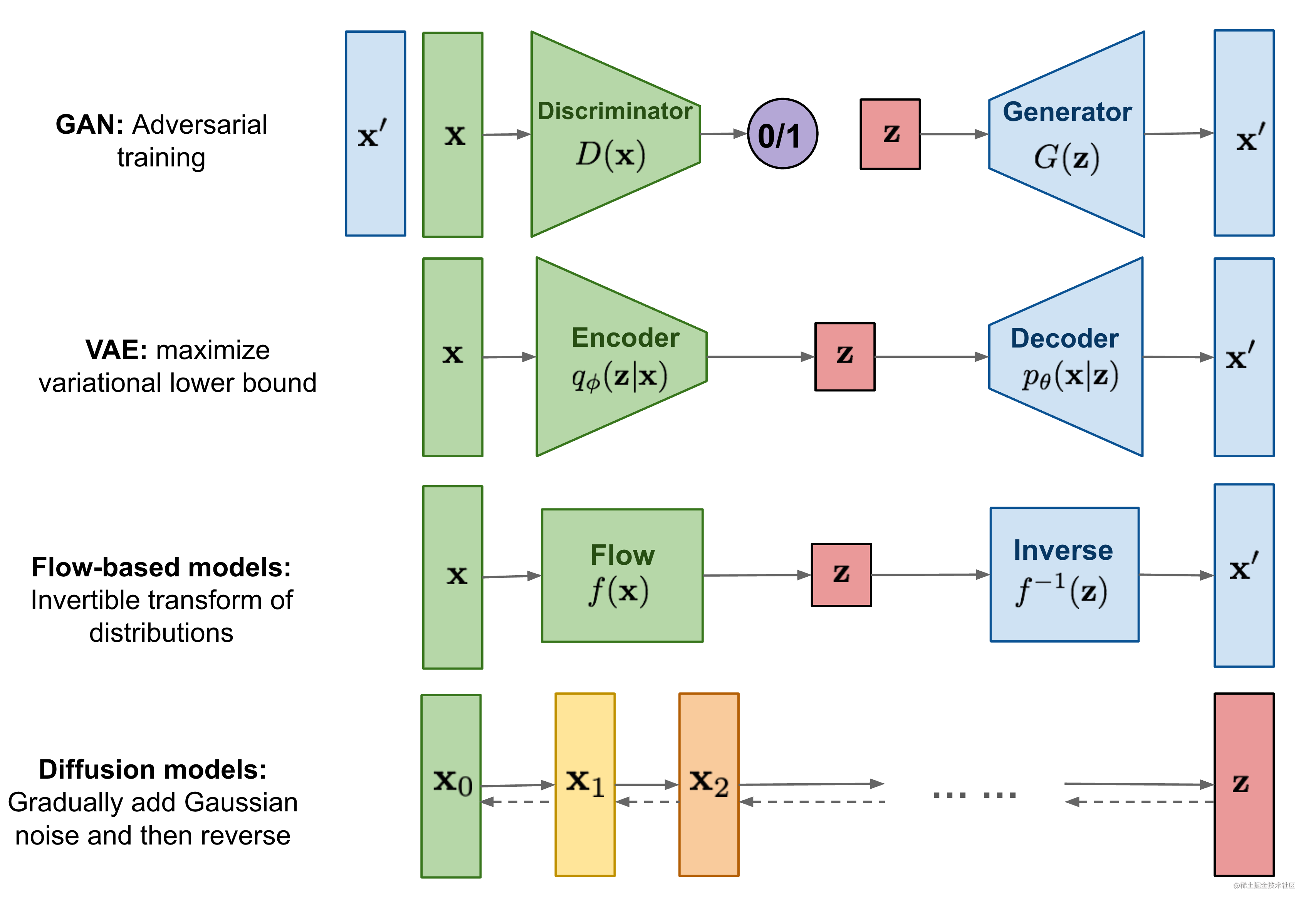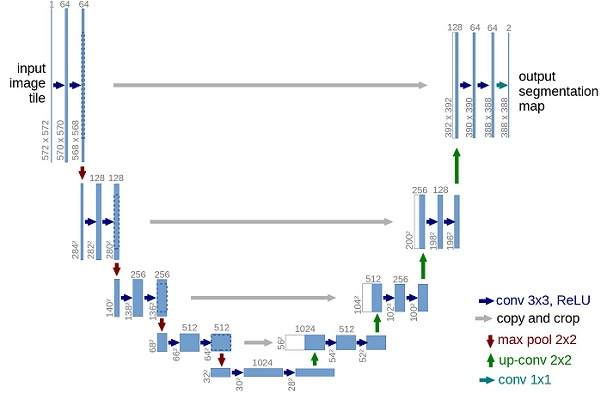文章目录
昇思MindSpore应用实践
本系列文章主要用于记录昇思25天学习打卡营的学习心得。
基于MindSpore的Diffusion扩散模型
1、Diffusion Models 简介
关于生成式模型,主要有GANs,VAEs,Flow Models,Diffusion Models,其中最常用的模型主要是生成对抗网络(GANs)和扩散模型(Diffusion Models),两种方法都能从潜在空间的随机噪声中采用并以对抗学习或反向扩散的方式,生成符合真实数据分布的结果,从而应用在各种生成式任务,如:图生图(风格转换)、文生图、语音转换、图像修复等。

采用GANs的生成方式训练和推理速度相比Diffusion通常较快,但容易产生模式崩塌。重复生成相同结果等问题。而扩散模型的训练更加稳定,且正向加噪过程和反向复原过程都可以通过严格的条件概率和贝叶斯公式推导证明,更具可解释性,缺点是由于需要多步的噪声去除过程,以计算出最符合原始数据分布的像素值从而生成高质量真实类别的图片,速度相比GANs慢。
2、构建 Diffusion Model 的准备工作
以 DDPM 生成图像为例,其前向过程就是给真实图片逐步添加噪声的过程,这个过程是固定的(Frozen),逐渐将高斯噪声添加到图像中,直到最终得到纯噪声。
扩散模型的正向与反向过程示意图:

实验部分,首先导入必要的mindspore接口:
import math
from functools import partial
%matplotlib inline
import matplotlib.pyplot as plt
from tqdm.auto import tqdm
import numpy as np
from multiprocessing import cpu_count
from download import download
import mindspore as ms
import mindspore.nn as nn
import mindspore.ops as ops
from mindspore import Tensor, Parameter
from mindspore import dtype as mstype
from mindspore.dataset.vision import Resize, Inter, CenterCrop, ToTensor, RandomHorizontalFlip, ToPIL
from mindspore.common.initializer import initializer
from mindspore.amp import DynamicLossScaler
ms.set_seed(0)
def linear_beta_schedule(timesteps): # 正向扩散时间步设置
beta_start = 0.0001
beta_end = 0.02
return np.linspace(beta_start, beta_end, timesteps).astype(np.float32)
mindspore官方文档中给出了构建一款Diffusion模型的帮助函数和类,用于神经网络的实现:
def rearrange(head, inputs): # 调整张量分布
b, hc, x, y = inputs.shape # 输入形状
c = hc // head # 显然是用到了多头注意力机制,将特征维度分割为多个头处理
return inputs.reshape((b, head, c, x * y))
def rsqrt(x): # 计算逆平方根
res = ops.sqrt(x)
return ops.inv(res)
def randn_like(x, dtype=None): # 生成与输入张量x形状一致的随机张量
if dtype is None:
dtype = x.dtype
res = ops.standard_normal(x.shape).astype(dtype)
return res
def randn(shape, dtype=None): # 生成指定形状的随机张量
if dtype is None:
dtype = ms.float32
res = ops.standard_normal(shape).astype(dtype)
return res
def randint(low, high, size, dtype=ms.int32): # 生成一个指定形状的整数随机数张量
res = ops.uniform(size, Tensor(low, dtype), Tensor(high, dtype), dtype=dtype)
return res
def exists(x): # 判断某个变量是否被赋值
return x is not None
def default(val, d): # 用于设置默认值
if exists(val):
return val
return d() if callable(d) else d
def _check_dtype(d1, d2): # 检验数据类型是否兼容
if ms.float32 in (d1, d2):
return ms.float32
if d1 == d2:
return d1
raise ValueError('dtype is not supported.')
class Residual(nn.Cell): # 定义残差模块,源自何神CVPR2015的神来之笔
def __init__(self, fn):
super().__init__()
self.fn = fn
def construct(self, x, *args, **kwargs):
return self.fn(x, *args, **kwargs) + x
def Upsample(dim): # 上采样
return nn.Conv2dTranspose(dim, dim, 4, 2, pad_mode="pad", padding=1)
def Downsample(dim): # 下采样
return nn.Conv2d(dim, dim, 4, 2, pad_mode="pad", padding=1)
# 位置向量,源自Transformer中的位置编码,让网络知道它在哪个特定时间步长(噪声水平)上运行
class SinusoidalPositionEmbeddings(nn.Cell):
def __init__(self, dim):
super().__init__()
self.dim = dim
half_dim = self.dim // 2
emb = math.log(10000) / (half_dim - 1)
emb = np.exp(np.arange(half_dim) * - emb)
self.emb = Tensor(emb, ms.float32)
def construct(self, x):
emb = x[:, None] * self.emb[None, :]
emb = ops.concat((ops.sin(emb), ops.cos(emb)), axis=-1)
return emb
class Block(nn.Cell):
def __init__(self, dim, dim_out, groups=1):
super().__init__()
self.proj = nn.Conv2d(dim, dim_out, 3, pad_mode="pad", padding=1)
self.proj = c(dim, dim_out, 3, padding=1, pad_mode='pad')
self.norm = nn.GroupNorm(groups, dim_out)
self.act = nn.SiLU()
def construct(self, x, scale_shift=None):
x = self.proj(x)
x = self.norm(x)
if exists(scale_shift):
scale, shift = scale_shift
x = x * (scale + 1) + shift
x = self.act(x)
return x
# ResNet/ConvNeXT模块
class ConvNextBlock(nn.Cell):
def __init__(self, dim, dim_out, *, time_emb_dim=None, mult=2, norm=True):
super().__init__()
self.mlp = (
nn.SequentialCell(nn.GELU(), nn.Dense(time_emb_dim, dim))
if exists(time_emb_dim)
else None
)
self.ds_conv = nn.Conv2d(dim, dim, 7, padding=3, group=dim, pad_mode="pad")
self.net = nn.SequentialCell(
nn.GroupNorm(1, dim) if norm else nn.Identity(),
nn.Conv2d(dim, dim_out * mult, 3, padding=1, pad_mode="pad"),
nn.GELU(),
nn.GroupNorm(1, dim_out * mult),
nn.Conv2d(dim_out * mult, dim_out, 3, padding=1, pad_mode="pad"),
)
self.res_conv = nn.Conv2d(dim, dim_out, 1) if dim != dim_out else nn.Identity()
def construct(self, x, time_emb=None):
h = self.ds_conv(x)
if exists(self.mlp) and exists(time_emb):
assert exists(time_emb), "time embedding must be passed in"
condition = self.mlp(time_emb)
condition = condition.expand_dims(-1).expand_dims(-1)
h = h + condition
h = self.net(h)
return h + self.res_conv(x)
3、Attention 机制
接下来是大名鼎鼎的Attention模块,其中使用了多头自注意力机制和线性注意力机制,其时间和内存要求在序列长度上线性缩放,而不是在常规注意力中缩放:
class Attention(nn.Cell):
def __init__(self, dim, heads=4, dim_head=32):
super().__init__()
self.scale = dim_head ** -0.5
self.heads = heads
hidden_dim = dim_head * heads
self.to_qkv = nn.Conv2d(dim, hidden_dim * 3, 1, pad_mode='valid', has_bias=False)
self.to_out = nn.Conv2d(hidden_dim, dim, 1, pad_mode='valid', has_bias=True)
self.map = ops.Map()
self.partial = ops.Partial()
def construct(self, x):
b, _, h, w = x.shape
qkv = self.to_qkv(x).chunk(3, 1)
q, k, v = self.map(self.partial(rearrange, self.heads), qkv)
q = q * self.scale
# 'b h d i, b h d j -> b h i j'
sim = ops.bmm(q.swapaxes(2, 3), k)
attn = ops.softmax(sim, axis=-1)
# 'b h i j, b h d j -> b h i d'
out = ops.bmm(attn, v.swapaxes(2, 3))
out = out.swapaxes(-1, -2).reshape((b, -1, h, w))
return self.to_out(out)
class LayerNorm(nn.Cell):
def __init__(self, dim):
super().__init__()
self.g = Parameter(initializer('ones', (1, dim, 1, 1)), name='g')
def construct(self, x):
eps = 1e-5
var = x.var(1, keepdims=True)
mean = x.mean(1, keep_dims=True)
return (x - mean) * rsqrt((var + eps)) * self.g
class LinearAttention(nn.Cell):
def __init__(self, dim, heads=4, dim_head=32):
super().__init__()
self.scale = dim_head ** -0.5
self.heads = heads
hidden_dim = dim_head * heads
self.to_qkv = nn.Conv2d(dim, hidden_dim * 3, 1, pad_mode='valid', has_bias=False)
self.to_out = nn.SequentialCell(
nn.Conv2d(hidden_dim, dim, 1, pad_mode='valid', has_bias=True),
LayerNorm(dim)
)
self.map = ops.Map()
self.partial = ops.Partial()
def construct(self, x):
b, _, h, w = x.shape
qkv = self.to_qkv(x).chunk(3, 1)
q, k, v = self.map(self.partial(rearrange, self.heads), qkv)
q = ops.softmax(q, -2)
k = ops.softmax(k, -1)
q = q * self.scale
v = v / (h * w)
# 'b h d n, b h e n -> b h d e'
context = ops.bmm(k, v.swapaxes(2, 3))
# 'b h d e, b h d n -> b h e n'
out = ops.bmm(context.swapaxes(2, 3), q)
out = out.reshape((b, -1, h, w))
return self.to_out(out)
DDPM将U-Net的卷积和注意力层在注意力层之前进行组归一化:
class PreNorm(nn.Cell):
def __init__(self, dim, fn):
super().__init__()
self.fn = fn
self.norm = nn.GroupNorm(1, dim)
def construct(self, x):
x = self.norm(x)
return self.fn(x)
4、条件 U-Net
相比于普通的编解码结构(Encoder-Decoder),U-Net在编码器和解码器之间引入了跳跃连接,极大地改善了梯度流:

基于mindspore的U-Net实现:
将先前预定义的位置编码、ResNet/ConvNeXT、Self-Attention和组归一化,用于定义现在的神经网络中。
网络获取了一批(batch_size, num_channels, height, width)形状的噪声图像和一批(batch_size, 1)形状的噪音水平作为输入,并返回(batch_size, num_channels, height, width)形状的张量。
网络构建过程如下:
首先,将卷积层应用于噪声图像批上,并计算噪声水平的位置
接下来,应用一系列下采样级。每个下采样阶段由2个ResNet/ConvNeXT块 + groupnorm + attention + 残差连接 + 一个下采样操作组成
在网络的中间,再次应用ResNet或ConvNeXT块,并与attention交织
接下来,应用一系列上采样级。每个上采样级由2个ResNet/ConvNeXT块+ groupnorm + attention + 残差连接 + 一个上采样操作组成
最后,应用ResNet/ConvNeXT块,然后应用卷积层
最终,神经网络将层堆叠起来,并构成前向传播。
class Unet(nn.Cell):
def __init__(
self,
dim,
init_dim=None,
out_dim=None,
dim_mults=(1, 2, 4, 8),
channels=3,
with_time_emb=True,
convnext_mult=2,
):
super().__init__()
self.channels = channels
init_dim = default(init_dim, dim // 3 * 2)
self.init_conv = nn.Conv2d(channels, init_dim, 7, padding=3, pad_mode="pad", has_bias=True)
dims = [init_dim, *map(lambda m: dim * m, dim_mults)]
in_out = list(zip(dims[:-1], dims[1:]))
block_klass = partial(ConvNextBlock, mult=convnext_mult)
if with_time_emb:
time_dim = dim * 4
self.time_mlp = nn.SequentialCell(
SinusoidalPositionEmbeddings(dim), # 位置编码
nn.Dense(dim, time_dim),
nn.GELU(),
nn.Dense(time_dim, time_dim),
)
else:
time_dim = None
self.time_mlp = None
self.downs = nn.CellList([])
self.ups = nn.CellList([])
num_resolutions = len(in_out)
for ind, (dim_in, dim_out) in enumerate(in_out):
is_last = ind >= (num_resolutions - 1)
# 下采样阶段
self.downs.append(
nn.CellList(
[
block_klass(dim_in, dim_out, time_emb_dim=time_dim),
block_klass(dim_out, dim_out, time_emb_dim=time_dim),
Residual(PreNorm(dim_out, LinearAttention(dim_out))),
Downsample(dim_out) if not is_last else nn.Identity(),
]
)
)
mid_dim = dims[-1]
self.mid_block1 = block_klass(mid_dim, mid_dim, time_emb_dim=time_dim)
self.mid_attn = Residual(PreNorm(mid_dim, Attention(mid_dim)))
self.mid_block2 = block_klass(mid_dim, mid_dim, time_emb_dim=time_dim)
for ind, (dim_in, dim_out) in enumerate(reversed(in_out[1:])):
is_last = ind >= (num_resolutions - 1)
# 上采样阶段
self.ups.append(
nn.CellList(
[
block_klass(dim_out * 2, dim_in, time_emb_dim=time_dim),
block_klass(dim_in, dim_in, time_emb_dim=time_dim),
Residual(PreNorm(dim_in, LinearAttention(dim_in))),
Upsample(dim_in) if not is_last else nn.Identity(),
]
)
)
out_dim = default(out_dim, channels)
self.final_conv = nn.SequentialCell(
block_klass(dim, dim), nn.Conv2d(dim, out_dim, 1)
)
def construct(self, x, time): # 前向传播
x = self.init_conv(x)
t = self.time_mlp(time) if exists(self.time_mlp) else None
h = []
for block1, block2, attn, downsample in self.downs: # 下采样阶段
x = block1(x, t)
x = block2(x, t)
x = attn(x)
h.append(x)
x = downsample(x)
x = self.mid_block1(x, t)
x = self.mid_attn(x)
x = self.mid_block2(x, t)
len_h = len(h) - 1
for block1, block2, attn, upsample in self.ups: # 上采样阶段
x = ops.concat((x, h[len_h]), 1)
len_h -= 1
x = block1(x, t)
x = block2(x, t)
x = attn(x)
x = upsample(x)
return self.final_conv(x)
5、Diffusion 正向过程
首先使用T=200的时间步长,定义噪声添加过程中需要的各种变量:
# 扩散200步
timesteps = 200
# 定义 beta schedule
betas = linear_beta_schedule(timesteps=timesteps)
# 定义 alphas
alphas = 1. - betas
alphas_cumprod = np.cumprod(alphas, axis=0)
alphas_cumprod_prev = np.pad(alphas_cumprod[:-1], (1, 0), constant_values=1)
sqrt_recip_alphas = Tensor(np.sqrt(1. / alphas))
sqrt_alphas_cumprod = Tensor(np.sqrt(alphas_cumprod))
sqrt_one_minus_alphas_cumprod = Tensor(np.sqrt(1. - alphas_cumprod))
# 计算 q(x_{t-1} | x_t, x_0)
posterior_variance = betas * (1. - alphas_cumprod_prev) / (1. - alphas_cumprod)
p2_loss_weight = (1 + alphas_cumprod / (1 - alphas_cumprod)) ** -0.
p2_loss_weight = Tensor(p2_loss_weight)
def extract(a, t, x_shape):
b = t.shape[0]
out = Tensor(a).gather(t, -1)
return out.reshape(b, *((1,) * (len(x_shape) - 1)))
def q_sample(x_start, t, noise=None): # 前向扩散过程
if noise is None:
noise = randn_like(x_start)
return (extract(sqrt_alphas_cumprod, t, x_start.shape) * x_start +
extract(sqrt_one_minus_alphas_cumprod, t, x_start.shape) * noise)
def p_losses(unet_model, x_start, t, noise=None): # 模型的损失函数
if noise is None:
noise = randn_like(x_start)
x_noisy = q_sample(x_start=x_start, t=t, noise=noise)
predicted_noise = unet_model(x_noisy, t)
loss = nn.SmoothL1Loss()(noise, predicted_noise)# todo
loss = loss.reshape(loss.shape[0], -1)
loss = loss * extract(p2_loss_weight, t, loss.shape)
return loss.mean()
6、Diffusion 反向过程

可以通过上述过程,即Diffusion Models生成高质量的结果,如下图中的人脸图像均是生成出来的,并不是现实中实际的人脸:

7、Diffusion 模型训练
以Fashion_Mnist为例的 Diffusion 模型训练过程如下,具体完整代码可登录昇思大模型平台扩散模型的Jupyter notebook进行尝试,打印log如下:
# 定义动态学习率
lr = nn.cosine_decay_lr(min_lr=1e-7, max_lr=1e-4, total_step=10*3750, step_per_epoch=3750, decay_epoch=10)
# 定义 Unet模型
unet_model = Unet(
dim=image_size,
channels=channels,
dim_mults=(1, 2, 4,)
)
name_list = []
for (name, par) in list(unet_model.parameters_and_names()):
name_list.append(name)
i = 0
for item in list(unet_model.trainable_params()):
item.name = name_list[i]
i += 1
# 定义优化器
optimizer = nn.Adam(unet_model.trainable_params(), learning_rate=lr)
loss_scaler = DynamicLossScaler(65536, 2, 1000)
# 定义前向过程
def forward_fn(data, t, noise=None):
loss = p_losses(unet_model, data, t, noise)
return loss
# 计算梯度
grad_fn = ms.value_and_grad(forward_fn, None, optimizer.parameters, has_aux=False)
# 梯度更新
def train_step(data, t, noise):
loss, grads = grad_fn(data, t, noise)
optimizer(grads)
return loss
import time
epochs = 10
for epoch in range(epochs):
begin_time = time.time()
for step, batch in enumerate(dataset.create_tuple_iterator()):
unet_model.set_train()
batch_size = batch[0].shape[0]
t = randint(0, timesteps, (batch_size,), dtype=ms.int32)
noise = randn_like(batch[0])
loss = train_step(batch[0], t, noise)
if step % 500 == 0:
print(" epoch: ", epoch, " step: ", step, " Loss: ", loss)
end_time = time.time()
times = end_time - begin_time
print("training time:", times, "s")
# 展示随机采样效果
unet_model.set_train(False)
samples = sample(unet_model, image_size=image_size, batch_size=64, channels=channels)
plt.imshow(samples[-1][5].reshape(image_size, image_size, channels), cmap="gray")
print("Training Success!")
由于时间原因,只训练几个Epoch的可视化效果不是很好,loss未进入收敛状态。Fashion_Mnist单张输入只是28x28x1的shape,可以感受到diffusion的训练速度要比GAN慢了很多。如果时间充足,可以用Asend910尝试多跑几个epoch;


Reference
综述 - 扩散模型 - Diffusion Models
MindSpore官方文档-Diffusion扩散模型
annotated-diffusion
由浅入深了解Diffusion Model